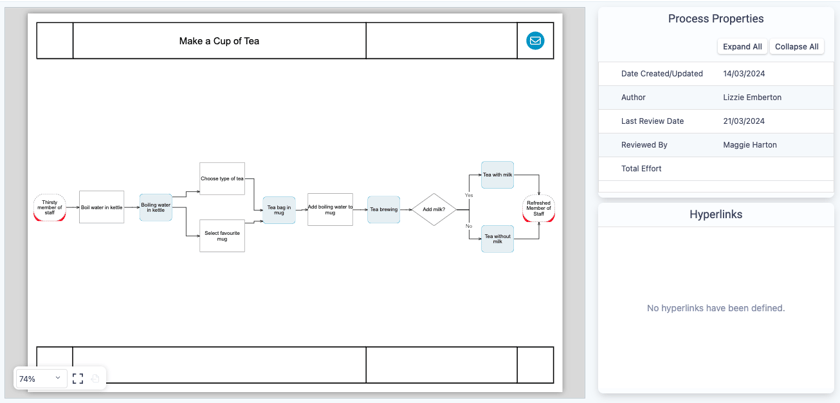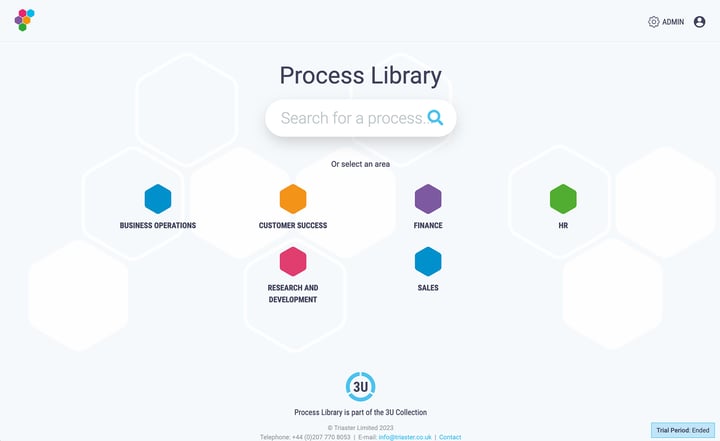A misconception many organisations have is that efficiency problems are due to a lack of employee engagement. However, if you don't have a standard way of working, the same task may be performed in 10 different ways by 10 different people. If your organisation is having business efficiency problems or you want to improve business efficiency, consider a Process Library. A Process Library ensures that employees perform the same task in the same (most efficient) way, every time.
In this article, look at what a Process Library is, how a Process Library can store documents and how a Process Library enables you to standardise your way of working and dramatically enhance your business efficiency. We will do this by exploring the following:
- What is a Process?
- What is a Process Library?
- What problems does a Process Library Solve?
- How can a Process Library help?
- How a Process Library delivers Cultural Change
- How a Process Library delivers Continual Improvement
- How to Get Started
What is a Process?
A Process is a method of doing or making something. A series of actions which transform inputs into outputs, taken to achieve a particular end.
This is most easily understood when thinking about the processing of physical goods, when a process is the mechanism by which raw materials are converted into products. For example, making a cup of tea will involve taking various elements, such as a mug, tea bag and boiling water (the inputs) and producing a cup of tea (the output) using a method (the process).

Although it is often easier to spot processes in physical terms, such as in manufacturing, we all use processes every day in our desk jobs for example when renewing a contract or recruiting a new employee.
What is a Process Library?
A Process Library is a Business Management System; however, it is far more than just a place to store documents. It is a 'Google for your Organisation', ensuring that everyone always knows what to do.

Process Libraries are searchable and contain process maps that describe:
- The tasks to be performed - in the form of policies, guides or process maps
- The deliverables produced - the outputs captured using templates provided
- The process workflow - the inherent dependencies
- How the work is to be performed - techniques used
- The tools that will be used to perform the work
- Employee roles and responsibilities
The process maps contained in process libraries can also contain links to documents, webpages, and other supporting information to ensure that anyone viewing a process map has all the information they need to complete the process.
What Problems Can be Solved With a Process Library?
Many organisations don't understand how much they need a process library. Of the frequently asked questions I receive most at Triaster, the 8 most common ones are:
- How do I get people to take ownership of their processes?
- How can I manage risk and avoid quality failure?
- We need to ensure when key people leave the business their knowledge doesn't go with them
- We need to get people working consistently
- How do we create a culture of continuous improvement?
- We are wasting too much money through inefficiency. How can we stop this?
- Our ISO certification seems to be running our business!
- The departments in our company all work in silos. We need to fix this.
All these problems (and more!) can be solved by implementing a process library - and ensuring the Process Library is useful, usable and used to increase business efficiency.
Put another way, think about your own organisation. How many problems could be solved by creating a single way of working for all business processes? How many efficiency problems could be solved by making processes easily accessible to the staff that need them? Process Libraries don't just store documents, they change organisational culture.
How Can a Process Library Help an Organisation?
Implementing a process library could help any organisation to:
- Break down silos
- Keep knowledge in the organisation, not in the person - when key people leave their knowledge should stay in the organisation
- Grant access to documents, webpages and supporting information that impacts process areas
- Support culture change and business efficiency
- Create greater employee responsibility and ownership of processes
- Documenting processes within a library captures a current process as it is so you can identify improvement opportunities
- Ensure your business management system is useful and used
- Make sure process changes are useful and deliver improvement
It is especially important to cater for the last two points because if your process library doesn't look great and feel easy to use it won't get used.
How a Process Library delivers Cultural Change
To fully deliver a process library must sit at the heart of the organisation, if it is seen as an optional add-on it won't get used or create any sort of change.
Simplicity, structure, and layout are key for employees to work efficiently and adopt a management system as a standard way of working.
This is why our customers often work with our designers to create a process library that presents their organisation's unique business management structure in a library that will have broad appeal and usability throughout their organisations.
How a Process Library delivers Continual Improvement
When embarking on a continuous improvement project it is important to have clarity on the current state (the way you do things today) and confidence that your new and improved state (your changed process) will be carried out correctly, by everyone who carries it out.
In other words, you cannot improve processes before:
- You know what they are - if you don't know how a process is broken or inefficient then you won't be able to fix it
- You have a standard way of working in your organisation - you can create the most efficient and least wasteful process on the planet but unless it's being used by employees who actually carry out the process then it's just a big waste of time and energy
Continual improvement only exists where the process is captured, shared, used then improved and the easiest way to ensure this is by using a process library.
How to Get Started
Triaster has been working in the continuous improvement and Business Process Management space for over 30 years and have developed and evolved Process Library so that users can quickly and easily capture how everyone should be working and share this information with all other users.
Now that you understand what a process library is and how it can help improve business efficiency (in theory), talk to us about how a Triaster process library could work for you.
Related Articles
Noun-Verb: A Simple Process Mapping Methodology
What is Continuous Improvement? A Simple Guide
As Is -To Be: The Essential Business Model for Process Improvement
Written by Giles Green
Giles joined Triaster in 2017 and is now our Business Improvement Director, working with organisations to increase efficiency, break down siloed working and improve their processes. Giles is passionate about solving business problems and how often a Process Library can do just that.
.jpeg)



